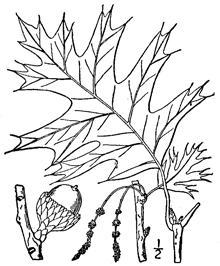Quercus velutina
 |
 |
Photo: Black Oak |
Britton & Brown |
| Botanical name: | Quercus velutina |
| Common name: | black oak |
| Group: | dicot |
| Family: | Fagaceae |
| Growth type: | tree |
| Duration: | perennial, deciduous |
| Origin: | native |
| Plant height: | 60-80’ |
| Foliage: | leaves are alternate |
| Berry/Seed: | acorn very rounded |
| Range in New Jersey: | statewide |
| Heritage ranking, if any: | n/a |
| Distribution: |  |
| Misc. | Readily distinguished from other oaks by its hairy buds and its leaves, which are lobed, bristle-tipped, and with hairs on the underside, the large hairs being stellate (branched). The Southern NJ’s most common oak species from the red and black oak group (those oaks with bristle-tipped leaves). Oaks support some of the forest’s greatest diversity. They begin to produce acorns at about 20 years and produces the greatest amount of acorns between 40-70 years. Many birds such as wild turkey, wood duck, quail, woodpeckers, thrashers, and chickadees forage on acorns; blue jays disperse them widely by planting acorns in soft soils. Mammals such as squirrels, deer, mice and other rodents consume acorns. Oaks are plagued by a number of diseases. |
| Credit: USDA United States Dept. of Agriculture, Natural Resources Conservation Service data base |
|